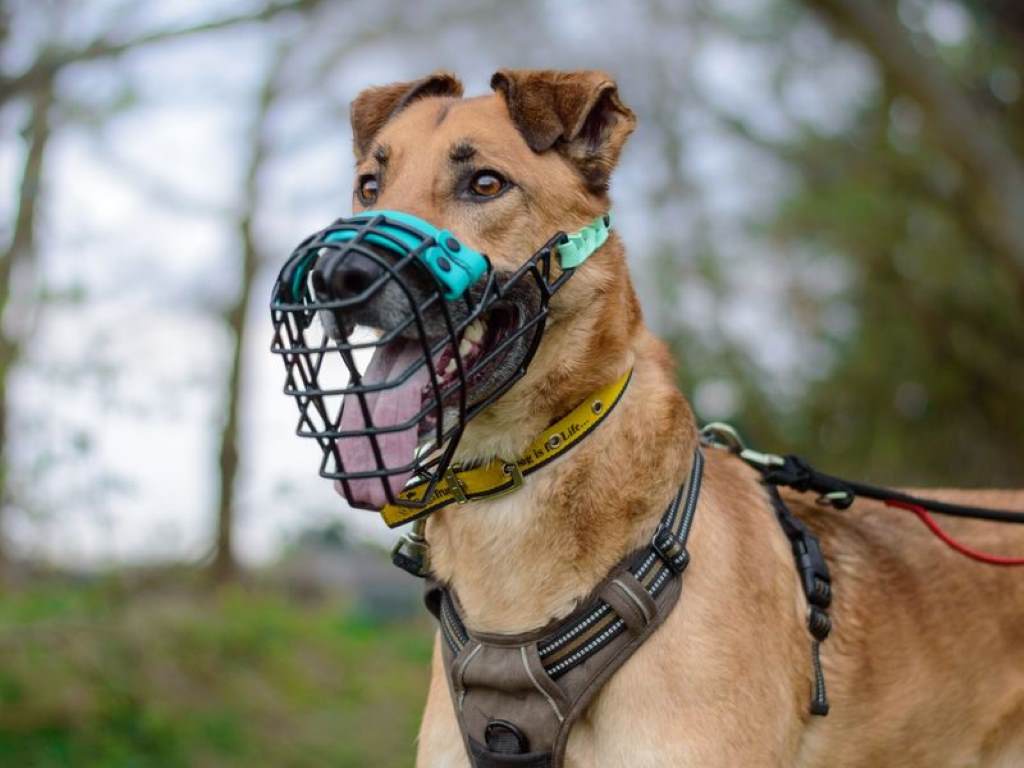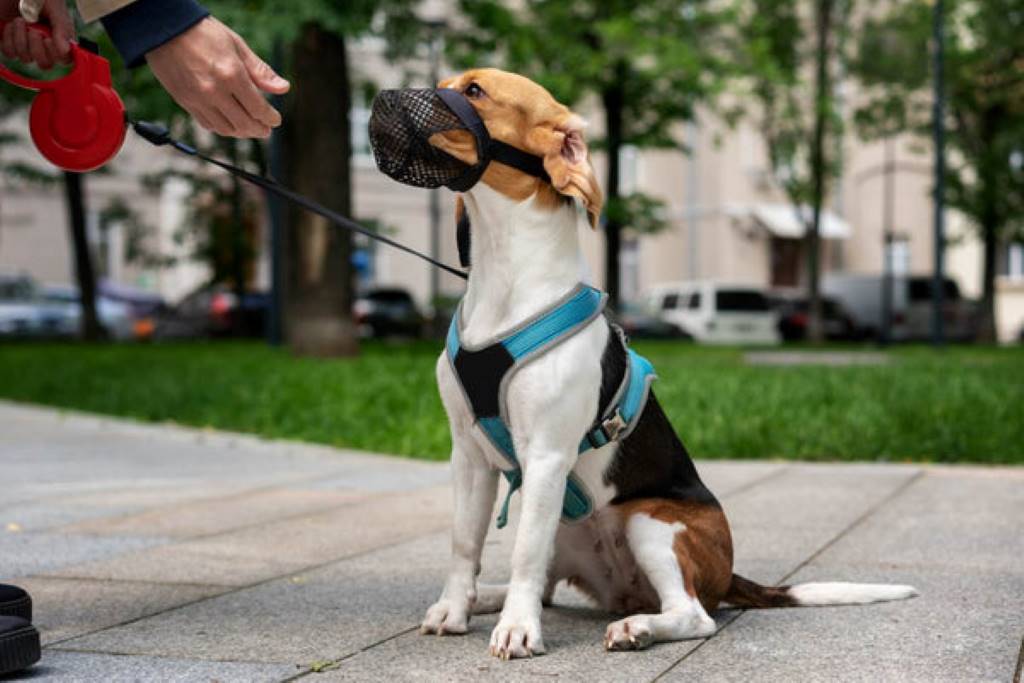
Imagine your dog snapping at a stranger. Or lunging during a vet visit. Your heart races. You want safety. For everyone. Muzzle training offers a solution. It teaches aggressive dogs to accept a muzzle comfortably. This tool prevents bites. Keeps walks calm. Makes vet trips stress-free.
Aggression often stems from fear. Or pain. A muzzle doesn’t fix the cause. It manages the behavior. You pair it with positive associations. Treats. Play. Your dog learns the muzzle means good things. Not punishment. This builds trust. Strengthens your bond.
Statistics highlight the need. In the US, 4.5 million dog bites occur annually. About 334,000 require emergency care. Fear drives most. Muzzle training reduces risks. It protects your dog. You. And others.
In the UK, the Animal Welfare Act 2006 emphasizes owner responsibility. Some breeds face breed specific legislation. Muzzles ensure compliance. Done right, it’s humane. Effective.
This guide covers every step. From choosing a muzzle to troubleshooting setbacks. You’ll learn practical tips. See real examples. Get ready to transform your dog’s behavior.
Table of Contents
ToggleWhy Muzzle Train Your Aggressive Dog?
Aggressive dogs react strongly. A growl at a passerby. A snap during nail trims. These moments spark worry. Muzzles provide safety. They cover the snout. Prevent bites. Allow panting. Drinking. Even eating treats.
Think of high-stress situations. Veterinary procedures like blood draws. Grooming sessions for nail trims. Muzzles keep staff safe. Your dog stays calm. You avoid chaos.
Public spaces demand caution. Parks. Public transportation. Urban tracking routes. Emergency responders prefer muzzled dogs. Long leashes add control. Muzzles add security.
Data supports this. Intact male dogs cause 70% of bites. Fearful ones top the list. Muzzle training addresses this. It buys time. You work on behavioral issues separately.
Without training, aggression worsens. Triggers grow. A muzzle bridges the gap. It’s a tool for safety. Not a cure. But it’s vital.
Benefits of Muzzle Training for Dog Owners
Muzzle training changes lives. Walks become enjoyable. No more lunging at strangers. Your dog stays calm. You relax.
Veterinarians approve. Muzzles make procedures smooth. Blood draws. Foreign object surgeries. Even GI upset exams. No stress. No bites.
Legal benefits matter too. Breed specific legislation affects certain dogs. Like German Shepherds. Or French Bulldogs. Muzzles ensure compliance. Avoid fines.
Brachycephalic breeds, like Australian cattle dogs, benefit. Short snouts need basket muzzles. They allow breathing. Prevent overheating.
Dog owners share success. One owner trained her reactive pup. Now it rides buses. Muzzled. Happy. Another used muzzles for vet grooming sessions. No fights.
Training strengthens bonds. You guide. Your dog trusts. Both win.
Choosing the Right Muzzle for Your Aggressive Dog
The right muzzle matters. It impacts training success. Basket muzzles lead for aggressive dogs. They allow panting. Drinking. Treats during training sessions. Brands like Baskerville Ultra stand out. Durable. Adjustable. Comfortable.
Soft muzzles work for quick tasks. Veterinary visits. But they restrict breathing. Not ideal for long wear. Skip them for training.
Brachycephalic dogs need special care. Short snouts, like in French Bulldogs, require basket muzzles. They ensure airflow. Prevent discomfort.
Measure carefully. Snout length. Eye to tip. Add 1-2 inches for space. Check width too. A fitted muzzle stays secure. Loose ones slip. Tight ones pinch.
Test the fit. Your dog should eat kibble through it. Drink water. Pant freely. If not, resize. Poor fits frustrate dogs. Cause resistance.
Avoid low-quality muzzles. They break. Cause stress. Invest in quality. Like Baskerville Muzzle. It lasts.
Customization helps. Add decorative tape for fun. Make it your dog’s style.
Step-by-Step Guide: How to Muzzle Train an Aggressive Dog
Training takes time. Patience. Positive reinforcement. Here’s how to do it right.
Step 1: Introduce the Muzzle
Start simple. Show the muzzle. Don’t force it. Place it near your dog. Offer tasty treats. Peanut butter works magic. Or try Tucker’s Chicken Jerky.
Let your dog sniff. Reward every glance. Keep sessions short. 5 minutes max. Do this daily. Build positive associations. Your dog learns: muzzle equals treats.
Watch body language. Tail wags mean comfort. Stiffness means slow down.
Step 2: Build Positive Associations
Move closer. Touch the muzzle to their nose. Reward instantly. Use high-value treats. Plato’s Made with Duck grabs attention. Food motivated dogs dive in.
Rub the muzzle gently. On their cheek. Chin. Reward each touch. No pressure. Keep it fun.
If your dog backs away, pause. Try again tomorrow. Short sessions prevent stress. Aim for 5-7 daily reps.
Step 3: Nose In, Quick Reward
Now lure the nose inside. Hold a treat in the muzzle. Let them reach. As their nose enters, reward. Clicker helps. Mark the moment. Give treats fast.
Start with 1-second holds. Then 2. Build to 5. Remove muzzle quickly. Keep it positive.
Use desensitization process. Gradual steps. No force. If they resist, go back a step.
Step 4: Secure and Stay
Buckle the muzzle. Reward big. Let them wear it for 10 seconds. Remove. Treat again.
Add a muzzle command. “Muzzle time.” Say it cheerfully. Pair with treats.
Walk around the house. Short bursts. 1 minute. Then 2. Reward movement. Make it normal.
Use training without conflict. Stay calm. End sessions on a high note.
Step 5: Practice in Real Life
Wear during meals. Place the food bowl down. Muzzle on. Let them eat. Builds comfort.
Try crate training. Muzzle during quiet time. Keeps it familiar.
Move outdoors. Use long leashes. Walk in low-stress areas. Like your yard. Then parks. Urban tracking spots.
Prep for vet visits. Start with car rides. Muzzle on. Short trips. Reward heavily.
Step 6: Troubleshoot Setbacks
Dog paws at muzzle? Shorten wear time. Add more treats. Check fit. Too tight hurts.
Growling? Back up steps. Rebuild trust. Use softer treats. Like peanut butter.
Seek help if stuck. A dog trainer spots issues. Online courses offer structure. Canine experts guide best.
Aim for 5-10 minute sessions. Daily. Consistency drives success.
Training Tips for Aggressive Dogs
- Aggressive dogs need special care. Positive reinforcement only. Never scold. It fuels fear.
- Set clear training goals. Like “wear muzzle 10 minutes.” Or “stay calm during walks.” Track progress.
- Pair with behavioral modification. Address triggers. Like strangers. Or loud noises. Muzzle supports while you train.
- Start puppy training early. Young dogs learn faster. Less resistance.
- Work with a dog trainer. They catch what you miss. Alison Schramel, a canine expert, shares tips online. Follow her.
- Brachycephalic dogs overheat. Use short sessions. Avoid midday sun.
- Soft muzzles work for quick tasks. Like vet visits. Basket muzzles suit play. Training sessions.
- Watch Muzzle Training Video guides. Visuals clarify steps.
- Social media groups help. Join Paws and Reflect. Share stories. Get advice.
Common Mistakes to Avoid in Muzzle Training
- Mistakes derail progress. Avoid these.
- Rushing. Dogs sense stress. Slow down. Build trust.
- Wrong size. Too tight pinches. Too loose slips. Measure twice.
- No rewards. Muzzle feels like punishment. Always use treats.
- Ignoring signals. Lip licks show fear. Pause. Reassess.
- Forcing it on. Causes hate. Lure with treats instead.
- Skipping practice. One session fails. Daily reps build habits.
- No fun. Add play. Toss treats. Keep dog engaged.
Advanced Techniques: Integrating Muzzle with Overall Behavior Training
- Muzzle training fits into bigger plans. Link it to a training program. Address behavioral problems.
- Use desensitization process for triggers. Like loud kids. Muzzle during exposure. Reward calm.
- Pharmacological intervention helps severe cases. Consult a vet. For anxiety. Or acute abdominal pain exams.
- Canine companions thrive with structure. Combine crate training. Leash work. Muzzle use.
- Join social media groups. Share tips. Learn from others. Muzzle Up! Project offers community.
- Read Paws and Reflect. Real stories inspire. Practical advice works.
- Behavior pet helpline helps. Call for quick tips. Veterinary Information Network has free resources.
Safety Considerations and Legal Aspects
Safety first. Keep a first aid kit handy. For scratches. Or mishaps.
Check legal rules. Animal Welfare Act 2006 demands welfare. Muzzles meet standards. Done humanely.
Breed specific legislation varies. Some areas require muzzles. Like for German Shepherds. Know your laws.
Veterinary hospital handouts guide. Ask for muzzle tips.
In public environments, warn others. “Muzzled dog.” Keeps people calm.
Brief emergency responders. Explain your dog’s training. They appreciate it.
Use in-app chat apps. Get real-time advice. From trainers. Or owners.
Case Studies
Max, a German Shepherd, bit twice. Fear-based. His owner used a basket muzzle. Daily positive reinforcement. Peanut butter rewards. In three weeks, vet visits calmed. Walks on long leashes? No issues. Max now hikes happily.
Luna, a French Bulldog, struggled. Brachycephalic breathing issues. Soft muzzle failed. Switched to Baskerville Ultra. Trained with chicken jerky. Now handles nail trims. Pants freely. Loves park walks.
Animal Humane Society ran a class. Ten reactive dogs. All muzzle trained. Eight weeks. All improved. Classes stayed safe. Owners gained confidence.
Sandra Robbins, a dog owner, shared her story. Her reactive pup hated muzzles. Took an online course. Followed desensitization process. Now public outings work. Muzzle on. Stress off.
These prove it. Time. Patience. Results follow.
Read Also:
Can Cats Eat Raw Quail Eggs? A Comprehensive Guide for Pet Parents
Is Neem Oil Safe for Dogs? A Complete Guide to Natural Pest Control for Your Furry Friends
Pet-Friendly Plants That Repel Fleas: A Natural Solution for Pet Owners
Resources for Dog Muzzle Training
Explore tools. Books like “Muzzle Train” guide steps. Online courses structure learning.
Find a dog trainer. Local ones know your dog’s needs.
Veterinary hospitals offer handouts. Free. Practical.
Use in-app chat apps. Quick trainer advice. Real-time.
Add decorative tape to muzzles. Makes them fun. Your dog’s style.
Try training exercises:
- Sniff game: Hide treats. Muzzle on. Find them.
- Treat toss: Toss jerky. Muzzle stays on.
- Calm sit: Reward sitting still. Muzzle worn.
Tolerance training builds comfort. Step by step.
Conclusion
Muzzle training transforms aggressive dogs. Walks turn fun. Vet visits calm. Safety grows. Trust deepens.
Choose a basket muzzle. Use positive reinforcement. Go slow. Practice daily. Troubleshoot setbacks. Pair with behavioral modification.
Start now. Grab treats. Fit the muzzle. Watch your dog relax. You’ll both enjoy life more.
FAQs
What is the best muzzle for aggressive dogs?
Basket muzzles excel. They allow panting. Drinking. Treats. Baskerville Ultra fits securely. Adjusts well. Ideal for training sessions.
How long does muzzle training take for an aggressive dog?
Progress shows in 1-3 weeks. Full comfort takes 4-8 weeks. Daily 5-10 minute sessions. Consistency speeds results. Patience seals it.
Can muzzle training help with behavioral issues?
Yes. It prevents bites during training process. Supports behavior modification. Eases stress in veterinary procedures or grooming.
Is muzzle training safe for brachycephalic breeds?
Safe with basket muzzles. They allow breathing. Avoid soft muzzles. Short sessions prevent overheating. Check fit carefully.
What treats work best for positive reinforcement in muzzle training?
High-value treats shine. Peanut butter. Tucker’s Chicken Jerky. Plato’s Made with Duck. Small portions keep food motivated dogs eager.

